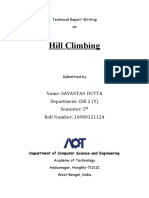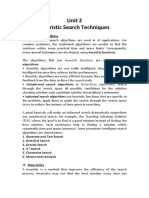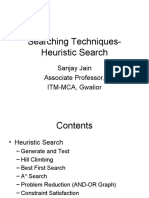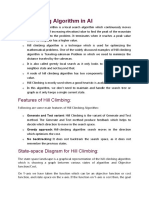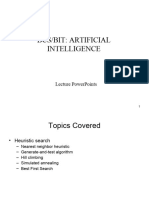Hill Climbing
Hill Climbing
Uploaded by
Slimani AhmedCopyright:
Available Formats
Hill Climbing
Hill Climbing
Uploaded by
Slimani AhmedCopyright
Available Formats
Share this document
Did you find this document useful?
Is this content inappropriate?
Copyright:
Available Formats
Hill Climbing
Hill Climbing
Uploaded by
Slimani AhmedCopyright:
Available Formats
Hill Climbing
1- Definition
Hill Climbing is a technique to solve certain optimization problems. In this technique, we
start with a sub-optimal solution and the solution is improved repeatedly until some condition
is maximized.
The idea of starting with a sub-optimal solution is compared to starting from the base of the
hill, improving the solution is compared to walking up the hill (or walking down), and finally
maximizing (or minimizing) some condition is compared to reaching the top of the hill.
Hence, the hill climbing technique can be considered as the following phases:
- Constructing a sub-optimal solution obeying the constraints of the problem
- Improving the solution step-by-step
- Improving the solution until no more improvement is possible
Hill Climbing technique is mainly used for solving computationally hard problems. It looks
only at the current state and immediate future state. Hence, this technique is memory efficient
as it does not maintain a search tree.
Algorithm: Hill Climbing
Evaluate the initial state.
Loop until a solution is found or there are no new operators
left to be applied:
- Select and apply a new operator
- Evaluate the new state:
goal → quit
better than current state → new current state
2- Iterative Improvement
In iterative improvement method, the optimal solution is achieved by making progress
towards an optimal solution in every iteration. However, this technique may encounter local
maxima. In this situation, there is no nearby state for a better solution.
This problem can be avoided by different methods. One of these methods is simulated
annealing.
Random Restart
This is another method of solving the problem of local optima. This technique conducts a
series of searches. Every time, it starts from a randomly generated initial state. Hence, optima
or nearly optimal solution can be obtained comparing the solutions of searches performed.
3- Problems of Hill Climbing Technique
Linearity
Finding neighbors is not easy especially for non-linear situations.
Local Maxima
Hill Climbing may converge to local maxima, instead of global maxima.
Ridges and Alleys
If the target function creates a narrow ridge, then the climber can only ascend the ridge or
descend the alley by zig-zagging. In this scenario, the climber needs to take very small steps
requiring more time to reach the goal.
Plateau
A plateau is encountered when the search space is flat or sufficiently flat that the value
returned by the target function is indistinguishable from the value returned for nearby
regions, due to the precision used by the machine to represent its value.
4- Complexity of Hill Climbing Technique
This technique does not suffer from space related issues, as it looks only at the current state.
Previously explored paths are not stored.
For most of the problems in Random-restart Hill Climbing technique, an optimal solution can
be achieved in polynomial time. However, for NP-Complete problems, computational time
can be exponential based on the number of local maxima.
5- Applications of Hill Climbing Technique
Hill Climbing technique can be used to solve many problems, where the current state allows
for an accurate evaluation function, such as Network-Flow, Travelling Salesman problem, 8-
Queens problem, Integrated Circuit design, etc.
Hill Climbing is used in inductive learning methods too. This technique is used in robotics
for coordination among multiple robots in a team. There are many other problems where this
technique is used.
6- Example
This technique can be applied to solve the travelling salesman problem.
First an initial solution is determined that visits all the cities exactly once. Hence, this initial
solution is not optimal in most of the cases. Even this solution can be very poor.
The Hill Climbing algorithm starts with such an initial solution and makes improvements to
it in an iterative way. Eventually, a much shorter route is likely to be obtained.
You might also like
- Housekeeping Management Final Exam ReviewDocument45 pagesHousekeeping Management Final Exam Reviewderniere danseNo ratings yet
- Hill Climbing AlgoDocument27 pagesHill Climbing Algonmmishra77No ratings yet
- AI Lab Assignmentc7Document5 pagesAI Lab Assignmentc7Sagar PrasadNo ratings yet
- What Is Hill Climbing AlgorithmDocument31 pagesWhat Is Hill Climbing AlgorithmNUREDIN KEDIRNo ratings yet
- Hill ClimbingDocument17 pagesHill Climbingwevem43603No ratings yet
- 07 Local SearchDocument31 pages07 Local SearchthebinarycodingNo ratings yet
- 2.3hill Climbing AlgorithmDocument5 pages2.3hill Climbing Algorithmsouravmaity94302No ratings yet
- Hill Climbing Algorithm in AI - JavatpointDocument2 pagesHill Climbing Algorithm in AI - Javatpointdagaranil061No ratings yet
- Hill Climbing AlgorithmDocument5 pagesHill Climbing AlgorithmBraj SubediNo ratings yet
- Report On Ai - 041533Document11 pagesReport On Ai - 041533AnkitNo ratings yet
- Hill Climbing Algorithm in AIDocument5 pagesHill Climbing Algorithm in AIAfaque AlamNo ratings yet
- Hill Climbing Algorithm in Artificial IntelligenceDocument6 pagesHill Climbing Algorithm in Artificial Intelligencemissionps23No ratings yet
- Sayan Ghosh AIDocument9 pagesSayan Ghosh AISayan GhoshNo ratings yet
- Hill ClimbingDocument10 pagesHill Climbingc19-1633-217No ratings yet
- Unit 2 AIDocument14 pagesUnit 2 AIPriyankaNo ratings yet
- 3 4optimizationDocument52 pages3 4optimizationashish.rawatNo ratings yet
- 2.1 Local Search Algorithm and Optimization ProbelmDocument20 pages2.1 Local Search Algorithm and Optimization ProbelmLathikaNo ratings yet
- Hill ClimbingDocument5 pagesHill Climbinggabby209No ratings yet
- CCATPREPARATION AI Module 3Document13 pagesCCATPREPARATION AI Module 3Vaishnavi GuravNo ratings yet
- Problem Graphs Matching Hill ClimbingDocument32 pagesProblem Graphs Matching Hill ClimbingRaghu SomuNo ratings yet
- Co 4Document56 pagesCo 4Gaddam YakeshreddyNo ratings yet
- Hill Climbing ALgorithmDocument19 pagesHill Climbing ALgorithmVikash YadavNo ratings yet
- HillDocument15 pagesHillahmedliet143No ratings yet
- Hill Climbing MethodsDocument14 pagesHill Climbing Methodsapi-370591280% (5)
- Searching Techniques-Heuristic Search: Sanjay Jain Associate Professor, ITM-MCA, GwaliorDocument54 pagesSearching Techniques-Heuristic Search: Sanjay Jain Associate Professor, ITM-MCA, GwaliorSanjay JainNo ratings yet
- SRDocument53 pagesSRMonisha KabramNo ratings yet
- What Is Hill Climbing AlgorithmlastDocument9 pagesWhat Is Hill Climbing AlgorithmlastNUREDIN KEDIRNo ratings yet
- Hill Climbing Algorithm in Artificial IntelligenceDocument6 pagesHill Climbing Algorithm in Artificial IntelligenceNirmal Varghese Babu 2528No ratings yet
- Search StrategiesDocument16 pagesSearch StrategiesFranklin DorobaNo ratings yet
- Assignment - 05: Shivam Kamlesh Yadav BEIT-B4 77Document6 pagesAssignment - 05: Shivam Kamlesh Yadav BEIT-B4 77Game TwitcherNo ratings yet
- Unit 2 Topic 5 Hill Climb SearchDocument27 pagesUnit 2 Topic 5 Hill Climb SearchawnuvpewgcwxqdutluNo ratings yet
- Module IiiDocument8 pagesModule IiifarispalayiNo ratings yet
- Introduction To Hill ClimbingDocument5 pagesIntroduction To Hill ClimbingtusharNo ratings yet
- Hill Climbing Algorithm in AIDocument4 pagesHill Climbing Algorithm in AImaa xeroxNo ratings yet
- Hill ClimbingDocument12 pagesHill ClimbingVishesh YadavNo ratings yet
- Heuristic SearchDocument49 pagesHeuristic SearchsaikiranNo ratings yet
- Infomed Search Part 2Document18 pagesInfomed Search Part 2niyati1120No ratings yet
- I S Unit 2Document4 pagesI S Unit 2rajchetna3No ratings yet
- OR5Document5 pagesOR5Blacky BlueNo ratings yet
- Bcs Lecture1 Part2 2023Document27 pagesBcs Lecture1 Part2 2023ISAAC SICHALWENo ratings yet
- Unit-2 AIDocument37 pagesUnit-2 AIRinku BathraNo ratings yet
- Lecture6-6 - 23494 - 6heuristic Search11Document30 pagesLecture6-6 - 23494 - 6heuristic Search11Vamsi KrrishNo ratings yet
- AI8Document7 pagesAI8ANANTHI KNo ratings yet
- Op Tim IzationDocument4 pagesOp Tim Izationhashim_mokhtar9286No ratings yet
- Unit III. Heuristic Search TechniqueDocument15 pagesUnit III. Heuristic Search Techniqueszckhw2mmcNo ratings yet
- Notes On AlgorithmDocument34 pagesNotes On Algorithmyiyenor596No ratings yet
- Rohini 70022663397Document12 pagesRohini 70022663397ratnababu.mNo ratings yet
- Hill ClimbingDocument11 pagesHill ClimbingRaghu SomuNo ratings yet
- 2nd Hill ClimbingDocument4 pages2nd Hill ClimbingMuhammad ZaidNo ratings yet
- 2nd Hill ClimbingDocument4 pages2nd Hill ClimbingMuhammad ZaidNo ratings yet
- Unit 2Document47 pagesUnit 2mukul.money2003No ratings yet
- AI Exp4 60004210231Document4 pagesAI Exp4 60004210231rajghag0409No ratings yet
- Unit 2 Part 1Document30 pagesUnit 2 Part 1abhinav vuppalaNo ratings yet
- SIMPLEX METHOD - QTM PresentationDocument18 pagesSIMPLEX METHOD - QTM Presentationpratham guptaNo ratings yet
- Brute Force AlgorithmsDocument9 pagesBrute Force AlgorithmsserachguruNo ratings yet
- AI Beyond Classical Search &CSPsDocument116 pagesAI Beyond Classical Search &CSPsshailaja.mNo ratings yet
- Greedy, Divide and Conquer, Dynamic ApproachDocument10 pagesGreedy, Divide and Conquer, Dynamic Approachsadaf abidNo ratings yet
- L25 Recap of Data Analysis PDFDocument3 pagesL25 Recap of Data Analysis PDFAnanya AgarwalNo ratings yet
- Hill ClimbingDocument1 pageHill ClimbingVikas SharmaNo ratings yet
- AI Expt 05Document3 pagesAI Expt 05manav patelNo ratings yet
- Tik Time BombDocument2 pagesTik Time BombDewaldt HuysamenNo ratings yet
- English P1 Ms Form 3 End Term 2022Document2 pagesEnglish P1 Ms Form 3 End Term 2022Ann KibeNo ratings yet
- Rock FragmentationDocument18 pagesRock Fragmentationnoni26No ratings yet
- Wiley - Find A Journal Match For Your ManuscriptDocument4 pagesWiley - Find A Journal Match For Your Manuscriptssk researchNo ratings yet
- Basic Concepts in Relativity and Early Quantum Theory - Resnick & HallidayDocument353 pagesBasic Concepts in Relativity and Early Quantum Theory - Resnick & HallidayFernando Espinosa100% (1)
- pl888226 Tod Inventory CutoffDocument21 pagespl888226 Tod Inventory Cutoffeltoquek0No ratings yet
- Mathematics: Quarter 1 - Module 1Document27 pagesMathematics: Quarter 1 - Module 1Lodivico MolinaNo ratings yet
- Catenary Eqn of 3d Cable StructureDocument9 pagesCatenary Eqn of 3d Cable StructureMukeshNo ratings yet
- Assignment 2 - Summary 2Document3 pagesAssignment 2 - Summary 2Sawsan jamilNo ratings yet
- Lps Prayer ManualDocument36 pagesLps Prayer ManualSureen NarangNo ratings yet
- PPA115D-TRO115D Issue 2 Umsebenzi - LODDocument7 pagesPPA115D-TRO115D Issue 2 Umsebenzi - LODGontse DubeNo ratings yet
- Cad Cam Lab Manual AnDocument54 pagesCad Cam Lab Manual AnPranjal SrivastavaNo ratings yet
- ABMA Water GuideDocument1 pageABMA Water GuidesizmaruNo ratings yet
- 12 2018 Capital Planning FinalDocument6 pages12 2018 Capital Planning FinalVatsal UpadhyayNo ratings yet
- Ammeter Connection Diagram With Selector Switch and CT - ETechnoGDocument4 pagesAmmeter Connection Diagram With Selector Switch and CT - ETechnoGTakesure MarizaniNo ratings yet
- BSC Hons /information Systems/ 2 Year, Semester 1: Computer Quantitative MethodsDocument19 pagesBSC Hons /information Systems/ 2 Year, Semester 1: Computer Quantitative MethodsSimbarashe MataireNo ratings yet
- Power Electronics Lab Manual-withoutreadingsandprepostlab-EE0314Document69 pagesPower Electronics Lab Manual-withoutreadingsandprepostlab-EE0314Sankaran Nampoothiri Krishnan100% (1)
- Desiro MainlineDocument4 pagesDesiro MainlineRodrigo SampaioNo ratings yet
- Atari VC PDFDocument530 pagesAtari VC PDFMário João Vicente75% (4)
- Pestle Analysis Template AssignmentDocument9 pagesPestle Analysis Template Assignmentabhinav vermaNo ratings yet
- 2SK30ATM: Low Noise Pre-Amplifier, Tone Control Amplifier and DC-AC High Input Impedance Amplifier Circuit ApplicationsDocument4 pages2SK30ATM: Low Noise Pre-Amplifier, Tone Control Amplifier and DC-AC High Input Impedance Amplifier Circuit Applicationsaldrako4No ratings yet
- Nglish Hindi Words Devanagari ScriptDocument3 pagesNglish Hindi Words Devanagari ScriptameendaNo ratings yet
- Amended MGT702 Major Project 2021Document23 pagesAmended MGT702 Major Project 2021kajal prasadNo ratings yet
- Design of 6 Storey Building in EtabsDocument51 pagesDesign of 6 Storey Building in EtabsMisqal A Iqbal100% (2)
- Performing Systematic Literature Review in Software EngineeringDocument29 pagesPerforming Systematic Literature Review in Software EngineeringRiry AmbarsaryNo ratings yet
- 36 - (Systems) (9) Saw Tooth Structures (2016)Document232 pages36 - (Systems) (9) Saw Tooth Structures (2016)shakerxxooNo ratings yet
- Technical Data Polyfloor MortarDocument3 pagesTechnical Data Polyfloor MortarMeliany SariNo ratings yet
- SQL Server2008 DBADocument263 pagesSQL Server2008 DBAStelian CorbutNo ratings yet
- Final - Highway Surveys and LocationDocument12 pagesFinal - Highway Surveys and LocationJaron FranciscoNo ratings yet










